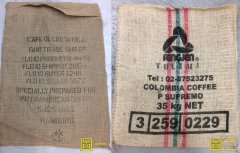Introduction to the Origin of Coffee Culture in Ethiopia Coffee Bean Story Ethiopian Coffee producing area
Ethiopia is the hometown of coffee and the cradle of mankind. There are different theories about the emergence of coffee. Once upon a time there was a shepherd named Caldi in Ethiopia. His daily pleasure was to write and sing while herding sheep. Whenever the sun went down, the happy Caldy would play the flute and summon the sheep home. But suddenly one day Caldy looked around after playing a little tune. Hey! Where's my sheep? Why didn't my sheep come back? The boy played the flute again, but the sheep still didn't come back! Qadir was worried. I thought, I'd better look for it. Mutton is very expensive!

After a stroll, he finally found the sheep, but he found them shouting excitedly on the hillside, running back and forth, especially hi! Carl is confused! What's wrong with this? Looking around and looking intently, he found that the sheep were eating the leaves and berries of a tree. And he had never noticed the tree before. The young man thought carefully that the tree must have made the sheep so high, so in the spirit of Shennong tasting all kinds of herbs, he decided to try these red berries! Hey, Caldy and his sheep. Oh, hey, Caldy. A small bite, a big step in the world. When Caldy finished chewing these red berries. I feel full of strength in an instant! Oh, I'll go! The whole body is full of strength, do not want the excitement! He also got high and danced, and even he had an impulse to write a hymn to his dear girlfriend! In this way, the coffee hidden in the forest was found! What a wonderful and romantic process of discovery.
With Caldi's discovery, more and more Ethiopians began to collect wild coffee. As the first humans to collect coffee, they only chewed berries at first, and later mixed coffee beans into powder and other meat to make food. Later, Ethiopians boiled coffee leaves and drank them as tea! (now they do the same.)
Until around 1400 (to be verified) a man accidentally roasted raw coffee beans while making a fire. Only to find that the smell of roasted coffee is so mellow and charming! So people began to think about grinding the roasted coffee and brewing it into a drink, inventing a powerful black drink! Since then, coffee has officially stepped onto the stage of human history!
Ethiopia is an ancient coffee producer, and about 90% of coffee is grown by small farmers in pastoral, semi-forest and forest areas. Small farmers form joint cooperatives to collaborate on production, which is responsible for dryness, grading and subsequent sales and exports.
Ethiopia is an area prone to drought. Water is a very precious resource. Therefore, only the best coffee cherries will be washed to remove the pulp; on the contrary, most raw coffee beans are sun-dried beans. The quality of sun-dried beans will be affected by the number of times farmers turn the beans and the weather and other factors. The whole sun-drying process takes about a month longer than water-washed beans, which increases uncertain variables. If not handled properly, the general sun-dried beans will have obvious defects in flavor.
A few years ago, the government changed the way coffee beans were traded, allowing the official ECX Exchange (Ethiopian Commodity Exchange) to collect and unify the harvests of small farmers around the country before pricing them at different levels. This changes the previous mode of purchasing raw beans directly from individual small farmers to protect farmers' interests through a fair trading platform, but it plays down the traceability information about the origin of coffee. The quality and flavor of coffee beans will be affected by factors such as different producing areas and treatment methods of mixed ginseng.
Ethiopia has several well-known coffee producing areas, such as Yirgacheffe, Sidamo, Harar and so on. The Sidamo producing area is located at 1400-2200 meters above sea level and uses the pastoral coffee system.
Shakisso/Shakiso, located in the Guji producing area of Sidamo, is one of the micro-producing areas with regional characteristics in the Sidamo producing area. The beans were treated by washing method, and the cup test score of the authoritative Coffee Review was 92, and the high-quality coffee (Speciality Coffee) had good flavor and quality.

Important Notice :
前街咖啡 FrontStreet Coffee has moved to new addredd:
FrontStreet Coffee Address: 315,Donghua East Road,GuangZhou
Tel:020 38364473
- Prev

Coffee cold knowledge: Colombian coffee beans can only use special sacks.
Professional barista communication Please pay attention to the coffee workshop (Wechat official account cafe_style) the common sacks in the market are like figure (1), which are commonly used in many countries, but they are different in Colombia! Colombia stipulates that raw coffee beans produced in Colombia can only use special sacks (figure 2), not other sacks! If what you receive is not dedicated
- Next

A detailed discussion on the characteristics, flavor and taste export of Colombian boutique coffee manor coffee
Colombian coffee is one of the few individual coffees sold in the world under its own name. In terms of quality, no other coffee has been so highly rated by coffee drinkers. It also has a very nice name, called Emerald Coffee. Colombians' relentless pursuit of coffee quality can only be described in one word: seriousness. In addition to serious, but also serious. In this respect, it is widely known.
Related
- Does Rose Summer choose Blue, Green or Red? Detailed explanation of Rose Summer Coffee plots and Classification in Panamanian Jade Manor
- What is the difference between the origin, producing area, processing plant, cooperative and manor of coffee beans?
- How fine does the espresso powder fit? how to grind the espresso?
- Sca coffee roasting degree color card coffee roasting degree 8 roasting color values what do you mean?
- The practice of lattes: how to make lattes at home
- Introduction to Indonesian Fine Coffee beans-- Java Coffee producing area of Indonesian Arabica Coffee
- How much will the flavor of light and medium roasted rose summer be expressed? What baking level is rose summer suitable for?
- Introduction to the characteristics of washing, sun-drying or wet-planing coffee commonly used in Mantenin, Indonesia
- Price characteristics of Arabica Coffee Bean Starbucks introduction to Manning Coffee Bean Taste producing area Variety Manor
- What is the authentic Yega flavor? What are the flavor characteristics of the really excellent Yejasuffi coffee beans?

